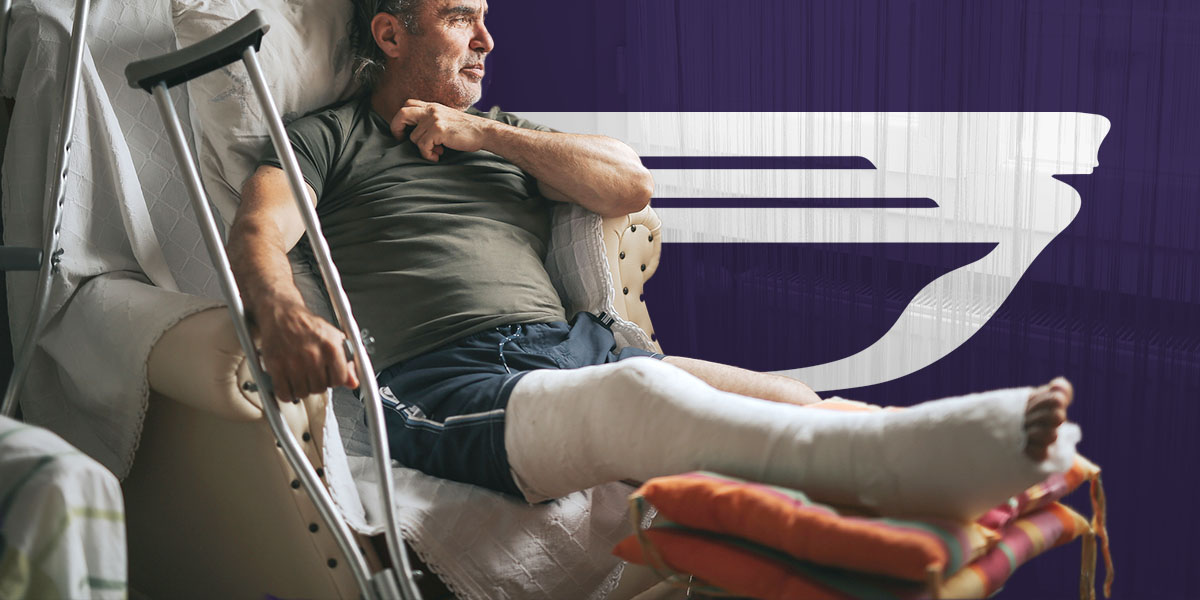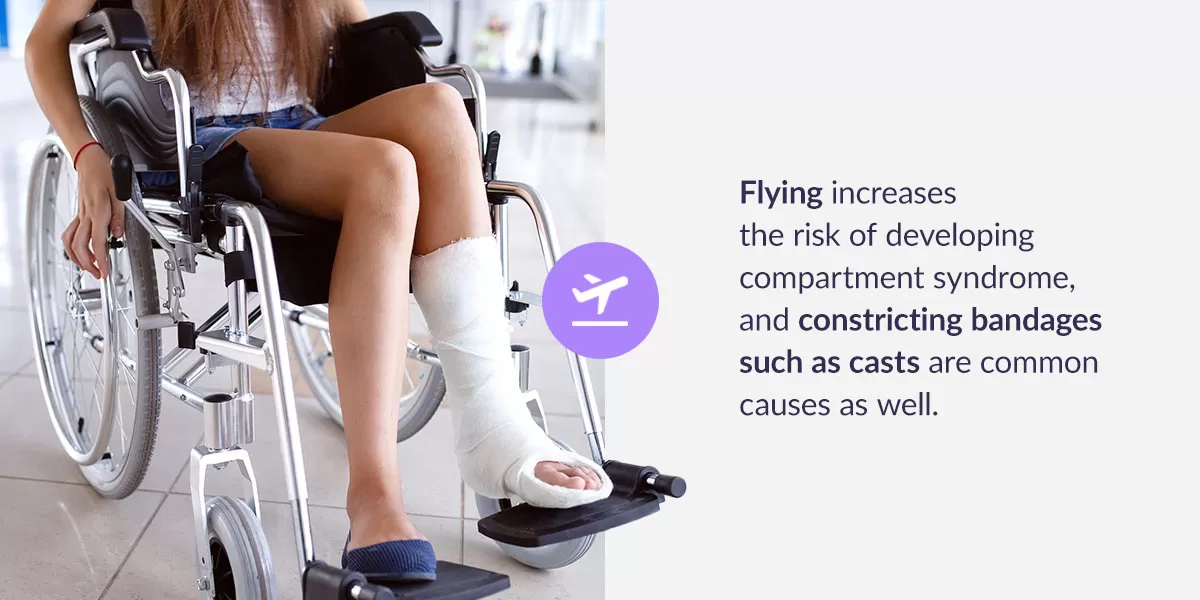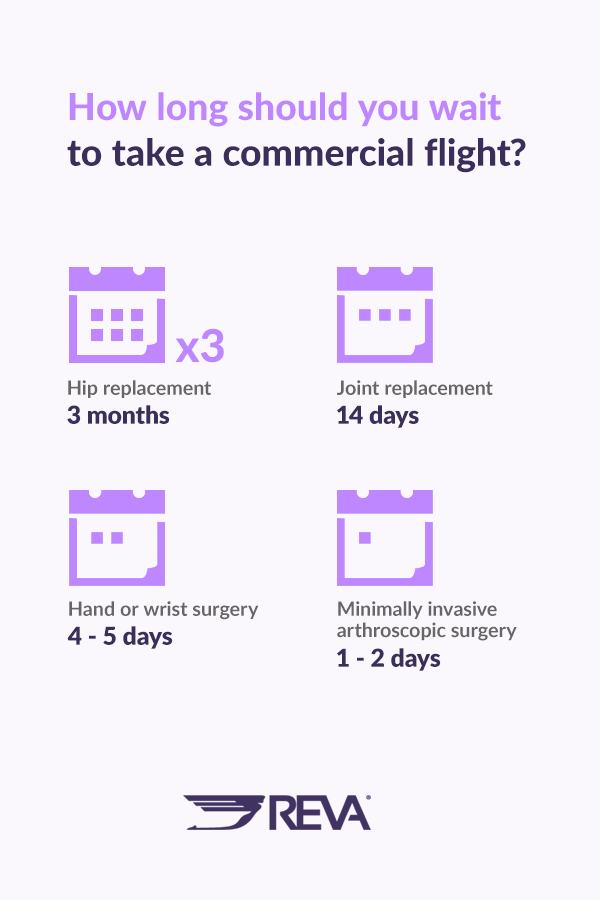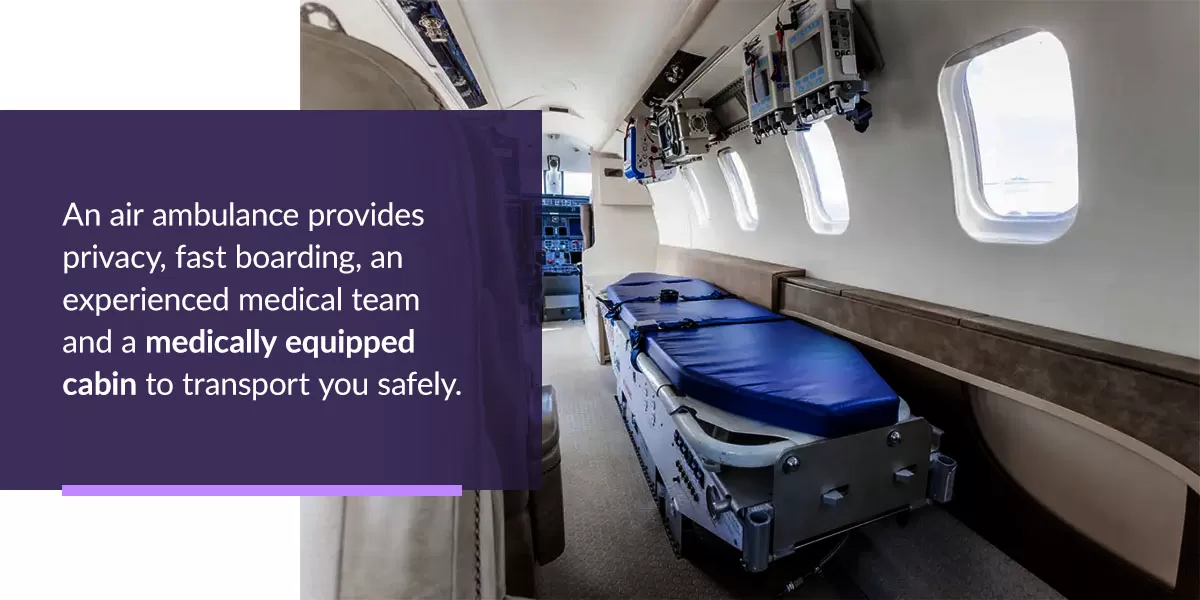Flying with a broken bone is possible, but the type of flight you can take depends on the type of injury you have and how recent it is. For example, you can typically fly on a commercial flight one to two days after receiving a cast for a broken arm or leg. However, a more extensive broken bone, such as a broken spine or hip, may require a specialized medical flight.
The pressure in an aircraft cabin at high altitudes increases the risk of compartment syndrome and deep vein thrombosis for passengers with broken bones. These risks are similar to other medical conditions you should not fly with, where safer travel alternatives may be necessary. Your health care provider can let you know if flying is safe for you, and they can recommend precautions to take so you have the safest flight possible.
In some cases, flying with a medical escort or booking an air ambulance is the best option because it provides medical monitoring and intervention when necessary.
Can You Fly on a Plane With a Broken Bone?
You can typically fly with a broken bone, but it’s important to consult with your doctor beforehand. You may also want to consider taking a medical escort along on your flight or scheduling an air ambulance for optimal care and safety.
In most cases, doctors recommend you wait at least 24 hours after a cast fitting to take a short flight and at least 48 hours to take a longer flight. If your doctor believes you’re at risk of complications, you can opt to fly with a medical escort or take an air ambulance flight to reach your destination safely.
Why Can’t You Fly With a Broken Bone Until 24 to 48 Hours Have Passed?
Waiting 24 to 48 hours after a cast fitting to take a flight reduces the risk of swelling. An affected area swells following an injury, and waiting a day or two before flying provides enough time for the swelling to go down. Swelling is a risk anytime a doctor fits you with a cast, but the risk of swelling increases on a flight due to decreased pressure and oxygen at higher altitudes.
Potential Consequences of Flying With a Broken Bone Against Medical Advice
Your health care provider can determine if you are safe to fly, but it’s important to understand why your provider may advise against flying. Consider the following potential risks of flying with a broken bone:
Compartment Syndrome
Acute compartment syndrome is dangerous pressure buildup in a muscle group following an injury. This pressure constricts blood flow, preventing muscle cells and nerves from receiving the oxygen and nourishment they require. Flying increases the risk of developing compartment syndrome because of low oxygen levels, decreased pressure and increased gaseous volume at high altitudes.
A compartment is a group of blood vessels, nerves and muscles in the arms and legs. For example, the area between a leg’s ankle and knee area contains four primary muscle compartments known as the deep posterior, superficial posterior, anterior and lateral compartments. A fascia is a tough membrane that covers a compartment to keep its tissues in place, and it has minimal expansion and stretching capabilities.
Because the fascia cannot stretch, bleeding or swelling within a muscle compartment can increase pressure on the compartment’s muscles, capillaries and nerves, leading to compartment syndrome. This condition can cause pain and potentially damage muscle and nerve cells, so you must relieve the pressure quickly if it occurs to prevent permanent tissue death and disability.
While various factors can lead to compartment syndrome, bone fractures and constricting bandages such as casts are common causes. Doctors typically advise patients to contact them immediately if they experience severe pain while wearing a cast because they must remove it quickly to relieve the pressure. An individual with compartment syndrome may also require supplemental oxygen, limb elevation, blood pressure support and a fasciotomy, depending on their vitals and the pressure severity.
Deep Vein Thrombosis
Deep vein thrombosis (DVT) is a blood clot that forms in one or more of the body’s deep veins, and it typically occurs in one or both legs. Bone fractures, lower limb surgery and long periods of immobilization can increase the risk of developing DVT.
Since flying involves sitting for long periods of time, it can raise your risk of DVT, especially if you travel with a broken bone. The longer your flight is, the higher the risk of developing DVT, and providers typically caution against flights longer than four hours if you have a high risk of DVT. If you develop DVT, fast treatment is important because it prevents further complications such as the following:
- Pulmonary embolism: A pulmonary embolism happens when a blood clot in the leg travels to the lungs, and it can deprive lung tissue of blood and oxygen. If an individual develops a pulmonary embolism, fast treatment is required for recovery. Treatment typically involves medication that can dissolve the clot to restore blood flow in the lungs.
- Leg ulcers: The legs can develop venous ulcers following DVT. This is because a clot can damage the lining of the veins.
Can You Fly After Orthopedic Surgery?
Some broken or fractured bones require surgery and a longer wait time before you take a flight. The more complicated a procedure, the longer a doctor will typically advise you to delay travel plans. For example, a hip replacement or spine surgery may require you to wait two weeks to a few months before flying commercially, but you may be able to fly a few days following a minimally invasive surgery. Consider how long you should wait to take a commercial flight after receiving the following types of procedures:
- Hip replacement: A hip replacement typically requires three months of healing before you can fly on a commercial aircraft.
- Joint replacement: Providers usually recommend waiting approximately 14 days after a joint replacement procedure to fly commercially.
- Hand or wrist surgery: A simple procedure on your hand or wrist may require you to wait four to five days after your surgery to fly on a commercial aircraft.
- Minimally invasive arthroscopic surgery: You can usually fly commercially a day or two after undergoing an arthroscopic or keyhole procedure.
If your health care provider advises against flying but you need to travel to another hospital or return home from another country, medical escort and air ambulance services are excellent alternatives. A medical escort or air ambulance can ensure you have the medical care necessary for a safe flight in your condition.
Tips for Flying With a Broken Bone
Whether you have a cast or recently underwent orthopedic surgery, taking care of your health and safety while flying is essential. If you need to travel with a broken bone, consider the following tips:
Talk to Your Provider
You should always talk to your provider before flying with a broken bone, even if you feel healed enough to travel. A plane’s cabin at high elevations is a much different environment than the ground, and you could face unforeseen complications if you fly against medical advice.
Ask your provider if it’s safe to fly, how long you should wait to fly and if there is anything you should do during your flight to prevent complications. Your doctor may recommend sticking to a short flight or walking around periodically to maintain good circulation.
It’s also helpful to request a note giving you medical permission to fly. Some commercial airlines require this documentation to allow you on the plane, so it’s good to carry it in case your chosen airline requests it.
Keep Your Broken Limb Elevated
Your provider may also recommend keeping your broken limb elevated. Keeping a broken leg or arm elevated during a flight reduces pressure and swelling. If you have a broken arm, your doctor may provide you with a sling you can wear during your flight, but a broken leg may require special seating arrangements for proper elevation.
For example, you may need to book three seats in a row so you can sit in one seat and prop your leg up on the other seats. Contact the airline before booking a flight to ensure they can accommodate this request. Some commercial airlines allow you to travel on a stretcher in certain situations. In this case, you can arrange for medical escort services and fly with an experienced medical provider who can address any potential complications.
Booking an air ambulance is an excellent way to ensure you can keep your limb elevated during flight. An air ambulance accommodates you with a comfortable stretcher and a team of medical professionals to provide in-flight care on a private aircraft.
Maintain Good Circulation
As mentioned, your doctor may recommend maintaining good circulation during a flight to prevent blood clots. Consider standing and moving your legs or walking up and down the aisle of the plane if possible. Any type of movement can help increase blood flow.
Travel With a Companion
Traveling with a broken bone is safer and easier with a companion. If you have crutches or a cast, you may need extra help carrying your luggage and going through security. Wearing a cast often requires additional security screening before boarding your plane, so it’s helpful to have an extra person with you to help you along the way.
You can typically store collapsible crutches in an aircraft’s overhead compartment, but you may need to check non-collapsible crutches and request wheelchair services if you have a broken leg. A medical escort can help you move through airport security, take care of your luggage, board your plane and enjoy a safe flight. Medical escorts monitor your health and address potential complications to ensure your safety.
Contact the Airline Before Your Flight
If you fly commercially, contacting the airline as soon as possible is important. Letting them know about your injury and specific accommodation needs can increase the chances of a smooth experience once you reach the airport. This also allows you to learn about the airline’s available accommodations early and change your travel plans if necessary.
Prioritize Your Rest
All injury types require adequate rest for proper healing. Traveling can be stressful, so it’s important to give yourself some extra time to rest before and after your flight. Packing, arranging transportation to the airport and boarding your flight can take a lot of energy, but arriving at the airport early can help you reduce stress in this process. You can also plan to set a day aside after you reach your destination to decompress.
Hydration and nutrition are also important for healing. Stay hydrated during your flight, and remember to eat a healthy breakfast, lunch and dinner even on the day of your flight.
Travel Via an Air Ambulance
Safety, comfort and convenience are important when traveling with a broken bone. An air ambulance provides privacy, fast boarding, an experienced medical team and a medically equipped cabin to transport you safely. When you book an air ambulance, an experienced flight paramedic team transports you to a private aircraft on a medical stretcher and monitors your health during the flight.
Air ambulances contain the necessary equipment to handle medical emergencies if complications arise during your flight, so you can rest assured you are safe. Air ambulances are also convenient because they allow you to avoid long security and baggage lines. Booking a medical flight means you have a team of professionals taking care of your needs throughout the entire travel process. Whether you need bed-to-bed hospital transfer or want to travel home from another country, an air ambulance team can keep you safe and comfortable along the way.
REVA’s Air Ambulance and Medical Escort Services
REVA offers air ambulance services to help you reach your destination safely and comfortably. Our aircraft are critical care units specially equipped with state-of-the-art medical supplies and equipment, and we customize each flight according to the client’s specific needs. An air ambulance is an excellent option for individuals who received recent orthopedic surgery and have a high risk of complications such as blood clots or compartment syndrome.
Our medical crew’s qualifications exceed federal and state requirements, and each team member completes ongoing training to ensure they provide the best care. REVA’s pilots have experience in commercial, medical and military aviation, and they follow strict aviation guidelines to meet or surpass industry safety credentials.
REVA also offers medical escort services, providing you with a trained medical professional to accompany you on your flight. Our medical escorts are highly-trained individuals who can help you board your flight, monitor your condition and provide emergency medical attention if any complications arise. A medical escort is a great option if you are concerned about potential risks regarding your broken bone and would like extra help and medical monitoring while traveling.
When you, your caregiver or a case manager book an air ambulance or medical escort, we take the following steps to facilitate a smooth process and prioritize your comfort and safety:
- Communicate with your insurance provider and collect information about your financial options
- Take care of your clinical documentation
- Arrange ground transportation to and from your flight
- Coordinate medical teams at the beginning and end of your trip
- Provide compassionate, quality care
Travel Safely With REVA
You can fly with a broken bone as long as you take the proper health and safety precautions. Speak with your doctor before booking a trip, and consider traveling with a medical escort or taking an air ambulance flight for optimal care. A highly-trained medical professional can closely monitor your health during your flight and address any complications if they arise.
REVA offers air ambulance and medical escort services that exceed industry standards and regulations. Our flight and medical teams have years of experience and undergo extensive training to ensure they provide the safest transportation and high-quality care. We can transport you to a better hospital via a private domestic or international flight, or we can help you return to your home country when you need medical repatriation. Contact REVA to request a quote or learn more about our services.





